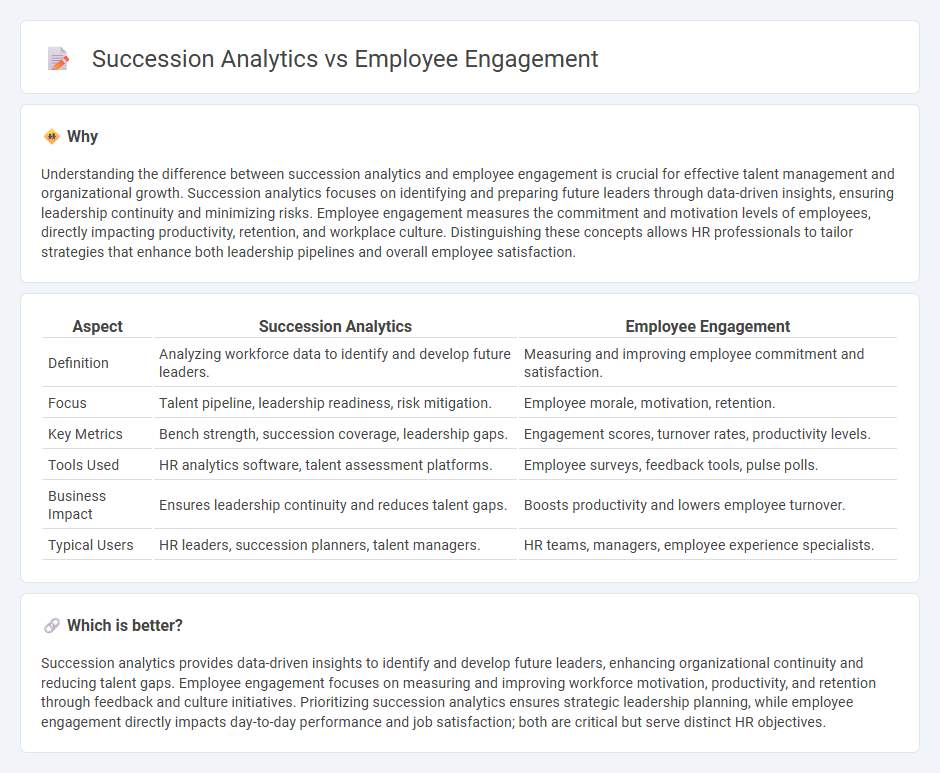
Succession analytics leverages predictive data models to identify and develop future leaders, ensuring organizational stability by mapping out talent pipelines. Employee engagement focuses on measuring workforce satisfaction and motivation levels to boost productivity and reduce turnover rates. Explore how integrating succession analytics with employee engagement strategies can drive comprehensive talent management.
Why it is important
Understanding the difference between succession analytics and employee engagement is crucial for effective talent management and organizational growth. Succession analytics focuses on identifying and preparing future leaders through data-driven insights, ensuring leadership continuity and minimizing risks. Employee engagement measures the commitment and motivation levels of employees, directly impacting productivity, retention, and workplace culture. Distinguishing these concepts allows HR professionals to tailor strategies that enhance both leadership pipelines and overall employee satisfaction.
Comparison Table
| Aspect | Succession Analytics | Employee Engagement |
|---|---|---|
| Definition | Analyzing workforce data to identify and develop future leaders. | Measuring and improving employee commitment and satisfaction. |
| Focus | Talent pipeline, leadership readiness, risk mitigation. | Employee morale, motivation, retention. |
| Key Metrics | Bench strength, succession coverage, leadership gaps. | Engagement scores, turnover rates, productivity levels. |
| Tools Used | HR analytics software, talent assessment platforms. | Employee surveys, feedback tools, pulse polls. |
| Business Impact | Ensures leadership continuity and reduces talent gaps. | Boosts productivity and lowers employee turnover. |
| Typical Users | HR leaders, succession planners, talent managers. | HR teams, managers, employee experience specialists. |
Which is better?
Succession analytics provides data-driven insights to identify and develop future leaders, enhancing organizational continuity and reducing talent gaps. Employee engagement focuses on measuring and improving workforce motivation, productivity, and retention through feedback and culture initiatives. Prioritizing succession analytics ensures strategic leadership planning, while employee engagement directly impacts day-to-day performance and job satisfaction; both are critical but serve distinct HR objectives.
Connection
Succession analytics leverages data-driven insights to identify and develop high-potential employees, directly influencing employee engagement by fostering clear career pathways and growth opportunities. Enhanced engagement metrics, such as job satisfaction and retention rates, provide critical feedback to refine succession planning strategies and align workforce development with organizational goals. Integrating these elements creates a dynamic talent management system that boosts productivity and sustains leadership pipelines effectively.
Key Terms
Motivation vs. Talent Pipeline
Employee engagement analytics measures workforce motivation by analyzing satisfaction, commitment, and productivity indicators to enhance organizational performance. Succession analytics focuses on building a robust talent pipeline by identifying and developing high-potential employees for future leadership roles. Explore how integrating these analytics can drive both motivation and strategic talent planning.
Retention vs. Leadership Development
Employee engagement analytics prioritize retention by measuring job satisfaction, motivation, and workplace culture, aiming to reduce turnover and improve productivity. Succession analytics focus on leadership development by identifying high-potential employees, assessing skills gaps, and planning career paths to ensure strong future leadership pipelines. Explore how integrating retention and leadership insights can optimize workforce stability and growth.
Feedback Mechanisms vs. Predictive Modeling
Employee engagement leverages feedback mechanisms such as surveys and real-time communication tools to gauge workforce satisfaction and morale. Succession analytics employs predictive modeling to identify future leadership potential and assess readiness based on historical performance and competency data. Explore deeper insights into how these approaches drive organizational growth and talent strategy evolution.
Source and External Links
Why Employee Engagement Is Key to Company Success - This article highlights the importance of employee engagement in boosting productivity, profitability, and employee retention, while also reducing absenteeism.
How to Improve Employee Engagement in the Workplace - This resource provides insights into how improving employee engagement can lead to higher productivity, lower absenteeism, and stronger customer loyalty.
What is Employee Engagement? - This webpage defines employee engagement and discusses its benefits, including increased productivity, higher employee retention, and improved customer satisfaction.
 dowidth.com
dowidth.com